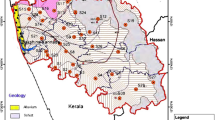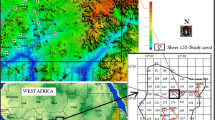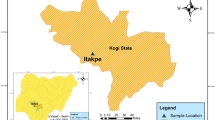Abstract
The natural radionuclide (238U, 232Th, and 40K) content of the 15 rock samples collected from Kolli hills along the Eastern Ghats, India, has been analyzed using a 4″ × 4″ NaI (Tl) scintillation detector-based gamma-ray spectrometer. The activity concentrations of 238U, 232Th, and 40K were between 12.97–49.89, 6.4–27.05, and 51.85–95.84 Bq kg−1, respectively. To understand the entire radiological characteristics of the collected samples, the various radiological hazard parameters have been calculated and were compared with the global recommended mean values. From the magnetic studies, values of χ ranged from 33.1 to 510.7 × 10−8 m3 kg−1. Moreover, in rock samples of Kolli hills, ferrimagnetic minerals are found to be the main magnetic carrier. Statistical analyses were performed to study the relation between the natural radionuclides, radiological hazard parameters, and magnetic minerals. The results of Pearson’s correlation analysis shows that 238U and 232Th strongly correlate with the radiological hazard parameters, and a poor correlation was noted between magnetic and radiological parameters. However, a positive and a near-positive correlation was also observed between SIRM/χ (0.501–0.578) and κFD% (0.471–0.481) with U and Th activity concentrations, respectively. This indicates that the carrier and grain size dependence parameters also play a significant role in increasing the activity concentrations of U and Th and its associated radiological parameters. From the cluster analysis, it is found that the content of ferrimagnetic minerals is higher in sample nos. 4, 5, 11, and 12, which greatly improves the properties of concrete when used for building construction purposes.






Similar content being viewed by others
References
Bartington Instruments Ltd. (1994) Operation manual. Environmental magnetic susceptibility—using the Bartington MS2 system. Chi Publishing, Kentworth, p 54
Beretka J, Mathew P (1985) Natural radioactivity of Australian building materials, industrial waste and byproducts. Health Phys 48:87–95
Chaparro MAE, Gargiulo JD, Irurzun MA, Chaparro MAE, Lecomte KL, Böhnel HN, Córdoba FE, Vignoni PA, ManograssoCzalbowski NT, Lirio JM, Nowaczyk NR, Sinito AM (2014) El uso de parámetrosmagnéticos en estudiospaleolimnológicos en Antártida “Magnetic parameters in paleolimnological studies in Antarctica”. Latin Am J Sedimentol Basin Anal 21(2):77–96
Dearing J, Dann R, Hay K, Lees J, Loveland P, Maher B, O’Grady K (1996) Frequency-dependent susceptibility measurements of environmental materials. Geophys J Int 124:228–240
Dunlop DJ, Özdemir Ö (1997) Rock magnetism, fundamentals and frontiers. Cambridge University Press, Cambridge, p 573
European Commission (EC) (1999) Radiological protection principles concerning the natural radioactivity of building materials. Radiation protection report no. 112. Directorate-general for environment, nuclear safety and civil protection
Gbadebo AM (2011) Natural radionuclides distribution in the granitic rocks and soils of abandoned quarry sites, Abeokuta, Southwestern Nigeria. Asian J Appl Sci 4:176–185
Gurugnanam B (2015) Analysis of digital elevation model of Kolli hill, south India using shuttle radar topography mission data and GIS techniques. Int J Remote Sens & Geosci 4(6):39–41
Gurugnanam B, Kalaivanan K, Bairavi S (2014) Detailed geomorphic mapping using remote sensing & GIS in Kolli Hill, South India. Int J Sci Res Dev 2(10):803–805
Harb S, El-Kamel AH, Zahran AM, Abbady A, As-Subaihi FAA (2012) Measurement of natural radioactivity in beach sediments from Aden coast on Gulf of Aden, south of Yemen. XI Radiation Physics and Protection Conference, Cairo, Egypt, pp 25–28
Iqbal M, Tufail M, Mirza SM (2000) Measurement of natural radioactivity in marble found in Pakistan using a NaI(Tl) gamma-ray spectrometer. J Environ Radioact 51(2):255–265
King J, Banerjee SK, Marvin J, Özdemir Ö (1982) A comparison of different magnetic methods for determining the relative grain size of magnetite in natural materials: some results from lake sediments. Earth Planet Sci Lett 59:404–419
Krisiuk EM, Tarasov SI, Shamov VP, Shlak NI, Lisachenko EP, Gomelsky LG (1971) A study of radioactivity in building materials. Research Institute for Radiation Hygiene, Leningrad
Krmar M, Slivka J, Varga E, Bikit I, Veskovic M (2009) Correlations of natural radionuclides in sediment from Danube. J Geochem Explor 100(1):20–24
Kumaresan N, Ilango K, Gopinath LR, Bhuvaneswari R, Archaya S (2016) Dynamics of plant hoppers diversity in Kolli Hills, Tamilnadu, India. Int J Fauna Biol Stud 3(1):93–97
Kurnaz A, Kucukomeroglu B, Keser R, Okumusoglu NT, Orkmaz F, Karahan G (2007) Determination of radioactivity levels and hazards of soil and sediment samples in Firtina valley (Rize, Turkey). Appl Radiat Isot 65:1281–1289
Maher BA, Thompson R, Hounslow MW (1999) Introduction. In: Maher BA, Thompson R (eds) Quaternary climate, environments and magnetism. Cambridge University Press, Cambridge, pp 1–48
Mantazul I, Chowdhury M, Alam MN, Hazari SKS (1999) Distribution of radionuclides in the river sediments and coastal soils of Chittagong, Bangladesh and evaluation of the radiation hazard. Appl Radiat Isot 51(6):747–755
Nagamalleswara Rao B (1995) Radiometric, magnetic susceptibility and mineralogical studies in some Beach places of Andhra Pradesh, East coast of India. J Geol Soc India 43:669–675
OECD (Organization of Economic Co-operation and Development) (1979) Exposure to radiation from natural radioactivity in building materials. Report by a Group of Experts of the OECD Nuclear Energy Agency, Paris
Okedeyi AS, Gbadebo AM, Mustapha AO (2014) Effects of physical and chemical properties on natural radionuclides level in soil of quarry sites in Ogun State, Nigeria. J Appl Sci 14(7):691–696
Olarinoye IO, Sharifat Baba-Kutiga AN, Kolo MT, Aladeniyi K (2010) Measurement of background gamma radiation level at two tertiary institutions in Minna, Nigeria. J Appl Sci Environ Manag 14:59–62
Peters C, Dekkers MJ (2003) Selected room temperature magnetic parameters as a function of mineralogy, concentration and grain size. Phys Chem Earth 28:659–667
R Core Team (2017) R: a language and environment for statistical computing. R foundation for statistical computing, Vienna.Version 3.4.3. https://www.R-project.org/. Accessed 25 Jan 2018
Ramasamy V, Suresh G, Venkatachalapathy R, Ponnusamy V, Meenakshisundaram V (2010) Magnetic susceptibility and radiological hazardous nature of the river sediments-spectroscopical approach. Acta Phys Polonica A 118(4):701–711
Tanaskovic I, Golobocanin D, Miljevic N (2012) Multivariate statistical analysis of hydro chemical and radiological data of Serbian spa waters. J Geochem Explor 112:226–234
Taskin H, Karavus M, Ay P, Topuzoglu A, Hindiroglu S, Karahan G (2009) Radionuclide concentrations in soil and lifetime cancer risk due to the gamma radioactivity in Kirklareli, Turkey. J Environ Radioact 100(1):49–53
Thompson R, Oldfield F (1986) Environmental magnetism. Allen & Unwin, London, UK, p 227
Turhan S, Gündüz Lu (2008) Determination of specific activity of 226Ra, 232Th and 40K for assessment of radiation hazards from Turkish pumice samples. J Environ Radioact 99(2):332–342
UNSCEAR (1993) United Nations Scientific Committee on Effects of Atomic Radiation, “Sources and Effects of Ionising Radiation”, UNSCEAR Report, New York
UNSCEAR (2000) United Nations Scientific Committee on the Effect of Atomic Radiation. Sources and effects of ionizing radiation. Report to general assembly. United Nations Organization, New York
Verosub KL, Roberts AP (1995) Environmental magnetism: past, present and future. J Geophys Res 100(B2):2175–2192
Acknowledgements
The authors thank the Head and staff of the Physics Department, Gulbarga University, for their help in gamma-ray analysis. The authors also thank the Universidad Nacional del Centro de la Provincia de Buenos Aires (UNCPBA), and the National Council for Scientific and Technological Research (CONICET).
Author information
Authors and Affiliations
Corresponding author
Rights and permissions
About this article
Cite this article
Krishnamoorthy, N., Kerur, B.R., Mullainathan, S. et al. Behavior of Natural Radionuclides, Radiological Hazard Parameters, and Magnetic Minerals in Rock Samples of Kolli Hills, Eastern Ghats, India. Int J Environ Res 12, 399–412 (2018). https://doi.org/10.1007/s41742-018-0098-7
Received:
Revised:
Accepted:
Published:
Issue Date:
DOI: https://doi.org/10.1007/s41742-018-0098-7




